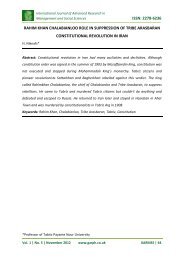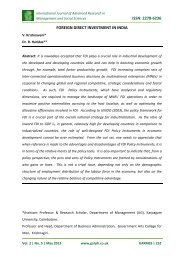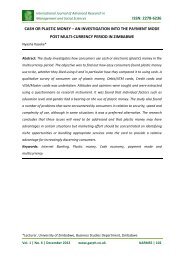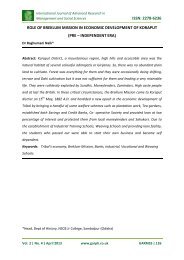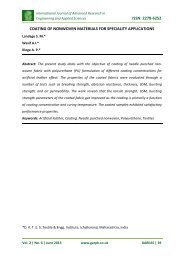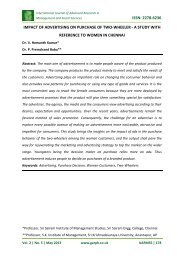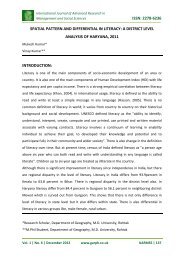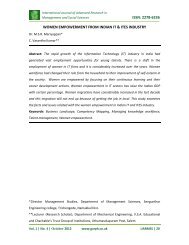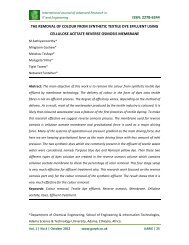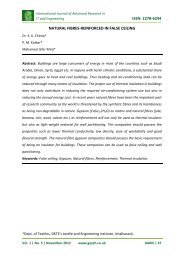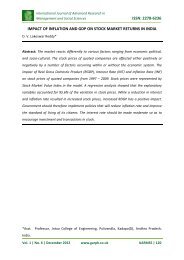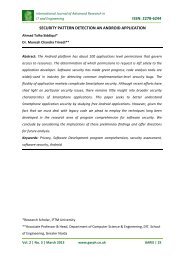issn: 2278-6236 role of financial inclusion through self ... - Garph.co.uk
issn: 2278-6236 role of financial inclusion through self ... - Garph.co.uk
issn: 2278-6236 role of financial inclusion through self ... - Garph.co.uk
You also want an ePaper? Increase the reach of your titles
YUMPU automatically turns print PDFs into web optimized ePapers that Google loves.
International Journal <strong>of</strong> Advanced Research in<br />
Management and Social Sciences ISSN: <strong>2278</strong>-<strong>6236</strong><br />
ROLE OF FINANCIAL INCLUSION THROUGH SELF HELP GROUP: A STUDY OF<br />
SELECTED SHGS IN YAMUNA NAGAR (DISTRICT HARYANA) INDIA<br />
Rekha Rathore*<br />
Manika Garg**<br />
Abstract: The <strong>financial</strong> <strong>inclusion</strong> emphasizes on <strong>co</strong>nversion <strong>of</strong> unbanked area into banked<br />
ones. Having a bank ac<strong>co</strong>unt does not mean <strong>financial</strong> Inclusion. The significant steps have<br />
been taken by Reserve Bank <strong>of</strong> India to penetrate unbanked areas. The future lies with those<br />
<strong>co</strong>mpanies who see Bottom <strong>of</strong> pyramid as their customer. We need to have <strong>co</strong>mprehensive<br />
methods to measure the reach <strong>of</strong> <strong>financial</strong> system to foster the <strong>financial</strong> <strong>inclusion</strong> across the<br />
<strong>co</strong>untry. In <strong>financial</strong> <strong>inclusion</strong> index rank, India occupies 50 th place above Russia (83 rd<br />
position) but below china. Micr<strong>of</strong>inance <strong>through</strong> Self Help Groups (SHGs) has be<strong>co</strong>me an<br />
important vehicle to meet the savings and credit needs <strong>of</strong> the poor, especially women in<br />
rural areas. The purpose <strong>of</strong> study is to know the <strong>role</strong> <strong>of</strong> <strong>financial</strong> <strong>inclusion</strong> <strong>through</strong> <strong>self</strong> help<br />
group and for this the data will be <strong>co</strong>llected from NGOs, SHG, NABARD, Gramin Banks by<br />
using interview method. Study is limited to Yamuna Nagar district only. This study help to<br />
give an outlook about the current status <strong>of</strong> SHGs in Financial <strong>inclusion</strong> , by <strong>co</strong>nducting this<br />
study we are able to find out the problems faced by NGOs, SHG, NABARD, Gramin Banks and<br />
able to improve the success rate <strong>of</strong> SHG for the development <strong>of</strong> e<strong>co</strong>nomy and make it as a<br />
powerful tool in <strong>financial</strong> <strong>inclusion</strong>.<br />
*Asst. Pr<strong>of</strong>essor & Research Scholar, S.D. Institute <strong>of</strong> Mgt. and tech., Jagadhri.<br />
***Student MBA, S.D. Institute <strong>of</strong> Mgt. and tech., Jagadhri.<br />
Vol. 2 | No. 2 | February 2013 www.garph.<strong>co</strong>.<strong>uk</strong> IJARMSS | 121
International Journal <strong>of</strong> Advanced Research in<br />
Management and Social Sciences ISSN: <strong>2278</strong>-<strong>6236</strong><br />
INTRODUCTION<br />
Financial Inclusion is a very important initiative for the sustainable growth <strong>of</strong> a <strong>co</strong>untry. With<br />
a huge rural population, that is e<strong>co</strong>nomically challenged, Government in India has rolled out<br />
many initiatives like Rural Employment Guarantee Scheme, Sarva Shiksha Abhiyan<br />
(Education for All), Bharat Nirman Programme. But to support the growth, a <strong>co</strong>mmittee on<br />
Financial Inclusion (FI) was also formed in June 2006, with Dr. C Rangarajan as Chairman to<br />
re<strong>co</strong>mmend a strategy to achieve a higher Financial Inclusion in the <strong>co</strong>untry. India in last 15<br />
years has witnessed unprecedented growth in <strong>financial</strong> services, unfolded by liberalization<br />
and globalization <strong>of</strong> <strong>financial</strong> services due to adoption <strong>of</strong> Information Technology and<br />
unlocking <strong>of</strong> the regulatory framework. But alongside this positive development there are<br />
evidences that the formal <strong>financial</strong> sector still excludes a large section <strong>of</strong> population. As on<br />
March 2006, the saving ac<strong>co</strong>unts per 100 adult populations were 63 and credit ac<strong>co</strong>unts<br />
were only 16 in all India (RBI, BSR 2006). In 1992, India’s National Bank for Agricultural and<br />
Rural Development (NABARD) piloted the <strong>co</strong>ncept with 500 groups. Since then, the SHG<br />
movement has witnessed tremendous growth that brought about one <strong>of</strong> the world’s largest<br />
and fastest-growing networks for micro-finance. In 2007, some 40 million households were<br />
organized in more than 2.8 million SHGs that borrowed more than US$ 1 billion <strong>of</strong> credit<br />
from banks in 2006/7 alone (Reserve Bank <strong>of</strong> India 2008). Cumulative credit disbursed to<br />
SHGs amounted to some US$ 4.5 billion (or about 10% <strong>of</strong> total rural credit) in India<br />
(Garikipati 2008).<br />
1 Ac<strong>co</strong>rding to IISS (Invest India In<strong>co</strong>mes and Savings Survey, 2007), 55 percent <strong>of</strong> all the<br />
households do not have bank ac<strong>co</strong>unts, 97 percent do not have any health insurance and 61<br />
percent do not have life insurance<br />
FINANCIAL INCLUSION<br />
Financial Inclusion is delivery <strong>of</strong> basic banking services at an affordable <strong>co</strong>st to the vast<br />
sections <strong>of</strong> disadvantaged and low in<strong>co</strong>me groups. It includes access to formal <strong>financial</strong><br />
system such as <strong>financial</strong> institutions, markets and instruments, like savings, loans,<br />
remittances and insurance services, at affordable prices.<br />
Financial Inclusion can be thought <strong>of</strong> in two ways: One is exclusion from the payments<br />
system –i.e. not having access to a bank ac<strong>co</strong>unt. The se<strong>co</strong>nd type <strong>of</strong> exclusion is from<br />
1 http://www.idfresearch.org/Financial-Inclusion-0901.pdf, accessed on dated 02-04-2010.<br />
Vol. 2 | No. 2 | February 2013 www.garph.<strong>co</strong>.<strong>uk</strong> IJARMSS | 122
International Journal <strong>of</strong> Advanced Research in<br />
Management and Social Sciences ISSN: <strong>2278</strong>-<strong>6236</strong><br />
formal credit markets, requiring the excluded to approach informal and exploitative<br />
markets. Access to formal banking services has been available <strong>through</strong> the use <strong>of</strong><br />
intermediaries such as Self Help Groups (SHGs) and Micr<strong>of</strong>inance Institutions (MFIs). SHGs<br />
are usually groups <strong>of</strong> women who get together and pool their savings and give loans to<br />
members. Usually NGOs and National Bank for Agriculture and Rural Development<br />
(NABARD) promote and nurture these groups. The re<strong>co</strong>very experience has been very good<br />
from SHGs and there are currently 2.6 million SHGs linked to public sector banks reaching<br />
almost 40 million households <strong>through</strong> its members.<br />
GROWTH<br />
India in last 15 years has witnessed unprecedented growth in <strong>financial</strong> services, unfolded by<br />
liberalization and globalization <strong>of</strong> <strong>financial</strong> services due to adoption <strong>of</strong> Information<br />
Technology and unlocking <strong>of</strong> the regulatory framework. The banking sector responded<br />
quickly to the new technology; diversified in multiple services and thus the share <strong>of</strong> finance<br />
& related services in the gross domestic product increased to about 14 per cent in 2006-07<br />
from 11 per cent in 1991-92 (RBI, Annual Report 2006-07). But alongside this positive<br />
development there are evidences that the formal <strong>financial</strong> sector is still excludes a large<br />
section <strong>of</strong> population. As on March 2006, the saving ac<strong>co</strong>unts per 100 adult populations<br />
were 63 and credit ac<strong>co</strong>unts were only 16 in all India (RBI, BSR 2006). Reserve Bank <strong>of</strong> India<br />
(RBI) and Government <strong>of</strong> India (GOI) are very much <strong>co</strong>ncerned about the <strong>financial</strong> exclusion<br />
as expressed in various issues <strong>of</strong> Monthly Bulletins <strong>of</strong> RBI during 2006 & 2007 and Central<br />
Budget <strong>of</strong> 2007-08(5,1). One aspect <strong>of</strong> inclusive growth is <strong>financial</strong> <strong>inclusion</strong>. The process <strong>of</strong><br />
<strong>financial</strong> <strong>inclusion</strong> is an attempt to bring within the ambit <strong>of</strong> the organised <strong>financial</strong> system<br />
the weaker and vulnerable sections <strong>of</strong> society.<br />
Financial <strong>inclusion</strong> can be defined as the delivery <strong>of</strong> credit and other <strong>financial</strong> services at an<br />
affordable <strong>co</strong>st to the vast sections <strong>of</strong> the disadvantaged and low in<strong>co</strong>me groups. The Indian<br />
state put stress on providing <strong>financial</strong> services to the poor and underprivileged since<br />
independence. The <strong>co</strong>mmercial banks were nationalized in 1969 and were directed to lend<br />
40% <strong>of</strong> their loan able funds, at a <strong>co</strong>ncessional rate, to the priority sector. The priority sector<br />
included agriculture and other rural activities and the weaker strata <strong>of</strong> society in general.<br />
The aim was to provide resources to help the poor to attain <strong>self</strong> sufficiency. They had<br />
neither resources nor employment opportunities to be <strong>financial</strong>ly independent, let alone<br />
Vol. 2 | No. 2 | February 2013 www.garph.<strong>co</strong>.<strong>uk</strong> IJARMSS | 123
International Journal <strong>of</strong> Advanced Research in<br />
Management and Social Sciences ISSN: <strong>2278</strong>-<strong>6236</strong><br />
meet the minimal <strong>co</strong>nsumption needs. To supplement these efforts, the credit scheme<br />
Integrated Rural Development Programme (IRDP) was launched in 1980. But these supply<br />
side programs (ignoring the demand side <strong>of</strong> the e<strong>co</strong>nomy) aided by <strong>co</strong>rruption and leakages,<br />
achieved little. Further, ‘The share <strong>of</strong> the formal <strong>financial</strong> sector in total rural credit was<br />
56.6%, <strong>co</strong>mpared to informal finance at 39.6% and unspecified sources at 3.8%. [RBI 1992].<br />
Not only had formal credit flow been less but also uneven. The <strong>co</strong>llateral and paperwork<br />
based system shied away from the poor. The vacuum <strong>co</strong>ntinued to be filled by the village<br />
moneylender who charged interest rates <strong>of</strong> 2 to 30% per month (Rural Credit and Self Help<br />
Groups- Micr<strong>of</strong>inance needs and Concepts in India- K.G.Karmakar 1999). 70% <strong>of</strong><br />
landless/marginal farmers did not have a bank ac<strong>co</strong>unt and 87% had no access to credit<br />
from a formal source.( World Bank NCAER, Rural Financial Access Survey 2003)<br />
OBJECTIVES OF THE STUDY:<br />
1. To know the problems being faced by NABARD, NGO, bank & SHG.<br />
2. To develop a framework for improvement in <strong>financial</strong> <strong>inclusion</strong>.<br />
3. Suggestions for Role <strong>of</strong> <strong>financial</strong> <strong>inclusion</strong> <strong>through</strong> Self help group<br />
REVIEW OF LITERATURE:<br />
Khawari (2004) revealed that the establishment <strong>of</strong> micr<strong>of</strong>inance institutions (MFIs) worldwide<br />
for the provision <strong>of</strong> <strong>co</strong>llateral free loans to the poor <strong>through</strong> mechanisms and<br />
instruments not known to normal <strong>co</strong>mmercial banks has set new milestones in the field <strong>of</strong><br />
<strong>financial</strong> services. With 900 million households in the less developed <strong>co</strong>untries left without<br />
any access to formal <strong>financial</strong> services. Firpo (2005) suggested that the Micro development<br />
Finance Team (MFT) carried out pilot projects in Uganda to determine the <strong>role</strong> technology<br />
<strong>co</strong>uld play in increasing the reach <strong>of</strong> micr<strong>of</strong>inance. The <strong>co</strong>nclusions drawn from the study<br />
that business process change and the implementation <strong>of</strong> new technology should proceed in<br />
tandem; creative technology solutions are required to be tailored to the unique and <strong>of</strong>ten<br />
challenging needs in emerging markets and local <strong>co</strong>ntexts; and partnerships between MFIs<br />
and local <strong>co</strong>mpanies assist in reducing infrastructure <strong>co</strong>sts. Technologies such as the RTS can<br />
evolve and provide functionality that serves to build bridges between MFIs and the formal<br />
<strong>financial</strong> sector.Ghosh (2005) traced the evolution <strong>of</strong> the Micr<strong>of</strong>inance revolution in India as<br />
a powerful tool for poverty alleviation and women empowerment. Where institutional<br />
finance failed Micr<strong>of</strong>inance delivered, but the outreach is too small. Pahuja (2007)<br />
Vol. 2 | No. 2 | February 2013 www.garph.<strong>co</strong>.<strong>uk</strong> IJARMSS | 124
<strong>co</strong>ncluded that<br />
International Journal <strong>of</strong> Advanced Research in<br />
Management and Social Sciences ISSN: <strong>2278</strong>-<strong>6236</strong><br />
at analyzing the historical and the present state <strong>of</strong> the rural <strong>financial</strong><br />
system in India .The paper is divided into three major segments where Segment (I) presents<br />
the background <strong>of</strong> the rural <strong>financial</strong> system and also studies the problem <strong>of</strong> Financial<br />
exclusion, (II) segment deals with the institutions working for the rural <strong>financial</strong> system,<br />
segment (III) focuses on Micro Finance Institutions and deals with the analysis <strong>of</strong> the overall<br />
paradigm as it holds for the Micro Finance Institutions in India Yang, whitefeild & Boehme<br />
(2007) described that an empirical study <strong>of</strong> investigating recent trend and development <strong>of</strong><br />
the application <strong>of</strong> e-banking in rural areas and its e<strong>co</strong>nomic impact on local <strong>financial</strong><br />
institutions. The data used in this research are <strong>co</strong>llected <strong>through</strong> a web-based questionnaire<br />
survey. The research objective is to investigate how those smaller and <strong>co</strong>mmunity banks<br />
located in rural areas have attempted to catch up with their <strong>co</strong>unterparts in larger cities in<br />
terms <strong>of</strong> the application <strong>of</strong> e-banking, focusing on emerging issues and challenges. The<br />
results are discussed with managerial implications along with suggestions for future<br />
research. Rangarajan (2008) accessed that to finance by the poor and vulnerable groups is<br />
a prerequisite for poverty reduction and social <strong>co</strong>hesion . The objective <strong>of</strong> <strong>financial</strong> <strong>inclusion</strong><br />
is to extend the s<strong>co</strong>pe <strong>of</strong> activities <strong>of</strong> the organized <strong>financial</strong> system to include within its<br />
ambit people with low in<strong>co</strong>mes. Through graduated credit, the attempt must be to lift the<br />
poor from one level to another so that they <strong>co</strong>me out <strong>of</strong> poverty. Sharma (2009) studied the<br />
<strong>financial</strong> <strong>inclusion</strong> by channelizing existing re<strong>co</strong>urses. His <strong>co</strong>nclusions are that (i) use <strong>of</strong><br />
technology in the banking system is the most feasible solution for achieving <strong>financial</strong><br />
<strong>inclusion</strong>, and (ii) the implementation <strong>of</strong> technology should follow a top down approach.<br />
Anamika (2009) analyzed<br />
the efforts made by the government <strong>of</strong> India in the<br />
implementation <strong>of</strong> <strong>financial</strong> <strong>inclusion</strong>, identifies the barriers in the process and suggests<br />
strategies to ensure maximum <strong>financial</strong> <strong>inclusion</strong> for the underprivileged and unbanked<br />
areas. Prasher (2009) suggested that the root cause for advancement in banking sector in<br />
rural areas is the <strong>co</strong>st factor. Technology can help in cutting down the <strong>co</strong>st factor. Use <strong>of</strong> IT<br />
reduces the <strong>co</strong>sts <strong>of</strong> <strong>financial</strong> transactions, improves allocation <strong>of</strong> resources, and increases<br />
<strong>co</strong>mpetitiveness and efficiency. Most importantly, it enables to take any product or service<br />
to the general masses. IT has also enabled efficient, accurate and timely management <strong>of</strong> the<br />
increased transaction volume that <strong>co</strong>mes with a larger customer base.<br />
Vol. 2 | No. 2 | February 2013 www.garph.<strong>co</strong>.<strong>uk</strong> IJARMSS | 125
WORKING<br />
International Journal <strong>of</strong> Advanced Research in<br />
Management and Social Sciences ISSN: <strong>2278</strong>-<strong>6236</strong><br />
Nabard<br />
& Other<br />
Agencie<br />
sssss<br />
E<strong>co</strong>nomy<br />
growth<br />
Incentives NGO’s Guidance<br />
S<br />
H<br />
Approach for loan<br />
Approval <strong>of</strong> loan<br />
incentives G<br />
Interest for loan<br />
In<strong>co</strong>me<br />
Interest<br />
Banks<br />
PROFITS<br />
In the pursuit <strong>of</strong> e<strong>co</strong>nomic development NABARD (National Bank for Agriculture and Rural<br />
Development) who takes the initiative to develop SHG’s (Self Help Group) with the help <strong>of</strong><br />
an NGOs(Non Government Organization) and banks to empower the rural people to get <strong>self</strong><br />
employed and generate some in<strong>co</strong>me. SHG is group <strong>of</strong> people from a homogeneous social<br />
or e<strong>co</strong>nomic class, all <strong>of</strong> who <strong>co</strong>me together for addressing their <strong>co</strong>mmon problems. After<br />
the six month <strong>of</strong> <strong>co</strong>mmencement <strong>of</strong> SHG, they people approach to bank for the loan. After<br />
analysing the working and documentation <strong>of</strong> last six months bank approve the loan to the<br />
SHG and this loan will be used by the group for the working <strong>of</strong> SHG. Interest rate on the<br />
loan is nominal and the NABARD also provide subsidies to SHG. As the NABARD leading the<br />
Indian e<strong>co</strong>nomy towards i.e higher GDP and national in<strong>co</strong>me. NGO’S earning pr<strong>of</strong>its in form<br />
<strong>of</strong> incentive from NABARD. SHGs are earning in<strong>co</strong>me by utilising the loans for productive<br />
purposes. Interest paid by the NGO’s on loans are the in<strong>co</strong>me for the Banks.<br />
RESEARCH METHODOLOGY:<br />
Sample:<br />
50 SHGs, and 3 banks will be randomly selected with in Yamuna Nagar & Jagadhri.<br />
Sampling: Random sampling<br />
Sampling Design: Descriptive Research<br />
Tools: For this few public and private banks will be selected to know that how these banks<br />
provide <strong>financial</strong> education to underprivileged persons and debt <strong>co</strong>unselling to individuals<br />
who are indebted to formal and/or informal <strong>financial</strong> sectors. Different SHGs will be<br />
selected and data will be <strong>co</strong>llected <strong>through</strong> interviews. To know the <strong>role</strong> <strong>of</strong> <strong>financial</strong> literacy<br />
and credit <strong>co</strong>unselling centre Punjab National Bank, State Bank <strong>of</strong> India, ICICI Bank and HDFC<br />
Bank will be selected. To study the third objective and its sub objective, a primary study will<br />
Vol. 2 | No. 2 | February 2013 www.garph.<strong>co</strong>.<strong>uk</strong> IJARMSS | 126
International Journal <strong>of</strong> Advanced Research in<br />
Management and Social Sciences ISSN: <strong>2278</strong>-<strong>6236</strong><br />
be made <strong>through</strong> interview <strong>of</strong> bank managers, using unstructured interview and<br />
questionnaires filled by vulnerable group.<br />
Analysis: Data <strong>co</strong>llected for first and se<strong>co</strong>nd objective will be <strong>through</strong> primary method i.e.<br />
interview and for third objective data will be <strong>through</strong> se<strong>co</strong>ndary data i.e. journals, literature<br />
review.<br />
DATA ANALYSIS & INTERPRETATION:<br />
Mainly, members <strong>of</strong> the SHGs are women. Consequently, participation <strong>of</strong> women in the<br />
<strong>co</strong>untry’s e<strong>co</strong>nomic development is increasing. They also play an important <strong>role</strong> in elevating<br />
the e<strong>co</strong>nomic status <strong>of</strong> their families. This has led boost to the process <strong>of</strong> women’s<br />
empowerment.<br />
The SHG is the dominant micr<strong>of</strong>inance methodology in India. The operations <strong>of</strong> 15-25<br />
member SHGs are based on the principle <strong>of</strong> revolving the members’ own savings. External<br />
<strong>financial</strong> assistance –by MFIs or banks – augments the resources available to the groupoperated<br />
revolving fund. Savings thus precede borrowing by the members. In many SHG<br />
programmes, the volume <strong>of</strong> individual borrowing is determined either by the volume <strong>of</strong><br />
member savings or the savings <strong>of</strong> the group as a whole. Some NGOs operate micr<strong>of</strong>inance<br />
programmes by organising federations <strong>of</strong> SHGs to act as the MFI which obtains external loan<br />
funds in bulk to be channelled to the members via the SHGs. NABARD has facilitated and<br />
extensively supported a programme which entails <strong>co</strong>mmercial banks lending directly to<br />
SHGs rather than via bulk loans to MFIs. NABARD re-finances the loans <strong>of</strong> the <strong>co</strong>mmercial<br />
banks to SHGs. Self-help group is a method <strong>of</strong> organising the poor people and the<br />
marginalized to <strong>co</strong>me together to solve their individual problem. The SHG method is used by<br />
the government, NGOs and others worldwide. In 1991-92 NABARD started promoting <strong>self</strong>help<br />
groups on a large scale. And it was the real take-<strong>of</strong>f point for the ‘SHG movement’. In<br />
1993, the Reserve Bank <strong>of</strong> India also allowed SHGs to open saving ac<strong>co</strong>unts in banks. Facility<br />
<strong>of</strong> availing bank services was a major boost to the movement.<br />
In Figure 1, a graphic illustration is shown <strong>of</strong> a SHG Federation. Typically, about 15 to 50<br />
SHGs make up a Cluster / VO with either one or two representatives from each SHG.<br />
Depending on geography, several clusters or VOs <strong>co</strong>me together to form an apex body or an<br />
SHG Federation.<br />
Vol. 2 | No. 2 | February 2013 www.garph.<strong>co</strong>.<strong>uk</strong> IJARMSS | 127
International Journal <strong>of</strong> Advanced Research in<br />
Management and Social Sciences ISSN: <strong>2278</strong>-<strong>6236</strong><br />
Figure 1 Illustrative SHG Federation<br />
SHG Federation /<br />
Apex /<br />
Mandal Samakhya<br />
Cluster/Village<br />
Organization<br />
Cluster/ Village<br />
Organization<br />
Cluster/ Village<br />
Organization<br />
SHG SHG SHG SHG SHG<br />
SHG model in India<br />
In India three different models <strong>of</strong> linkage <strong>of</strong> SHGs to the <strong>financial</strong> institutions have emerged.<br />
They are:<br />
‣ Banks, themselves, form and finance the SHGs.<br />
‣ SHGs are formed by NGOs and other agencies but financed By banks.<br />
Banks finance SHGs with NGOs and other agencies as <strong>financial</strong> intermediaries.<br />
NGO<br />
Problems<br />
Banks<br />
•Problem in<br />
guidance<br />
•Legal provisions<br />
SHGs<br />
•Non utilization <strong>of</strong><br />
funds<br />
•lack <strong>of</strong> awareness,<br />
•lack <strong>of</strong> trust<br />
•improper<br />
ac<strong>co</strong>unting system<br />
• <strong>co</strong>nflict among<br />
the members<br />
•Non payment <strong>of</strong><br />
interest<br />
•Delay in interest<br />
payments<br />
•Illiteracy<br />
•Problem <strong>of</strong><br />
providing <strong>financial</strong><br />
literacy<br />
Vol. 2 | No. 2 | February 2013 www.garph.<strong>co</strong>.<strong>uk</strong> IJARMSS | 128
International Journal <strong>of</strong> Advanced Research in<br />
Management and Social Sciences ISSN: <strong>2278</strong>-<strong>6236</strong><br />
CHALLENGES FACED BY SELF HELP GROUPS:<br />
1. Security risk<br />
Pooled savings are <strong>of</strong>ten guarded by a designated sub-group or individual, and while these<br />
individuals may be trust worthy, the money <strong>co</strong>uld still be easily misplaced, if not stolen<br />
altogether.<br />
2. Risk <strong>of</strong> fraud<br />
Well established <strong>self</strong>-help groups may not face the perils <strong>of</strong> fraud because their longevity<br />
relies on the adoption <strong>of</strong> good governance principles; however, recently-formed <strong>self</strong>-help<br />
groups are susceptible to fraudulent activity by the designated ac<strong>co</strong>untants or even by<br />
group member.<br />
3. Lack <strong>of</strong> capital<br />
The loan requirement <strong>of</strong> the <strong>self</strong>-help group may easily exceed the pool <strong>of</strong> funds generated<br />
<strong>through</strong> savings from group members, especially <strong>co</strong>nsidering money lost <strong>through</strong> bad debts.<br />
4. Lack <strong>of</strong> management skills<br />
Self-help groups are <strong>of</strong>ten initiated by a small cluster <strong>of</strong> individuals from low-in<strong>co</strong>me groups.<br />
Even though the members have little formal education or exposure to running thriving<br />
businesses, they may manage the group efficiency when the group size is small.<br />
5) Limited <strong>financial</strong> strength hence limited borrowing capacity<br />
The another problem faced by the <strong>self</strong> help groups are limited <strong>financial</strong> strength which<br />
creates the problem to borrow the fund from outside,even if their paper work already get<br />
<strong>co</strong>mpleted.<br />
6) Lack pr<strong>of</strong>essionalism<br />
Members <strong>of</strong> the <strong>self</strong> help groups are illitrate and less qualified,due to which they are not<br />
having the perfect knowledge <strong>of</strong> starting the business and proceed it further.this shows that<br />
members <strong>of</strong> <strong>self</strong> help groups do not have the pr<strong>of</strong>essional knowledge.<br />
7) Marketing <strong>of</strong> production poses a major challenge for the SHG<br />
In today’s modern era, marketing <strong>of</strong> the product play a very important <strong>role</strong> to launch and<br />
proper enhancing the sale in cut throat <strong>co</strong>mpetition. So, this is very difficult for <strong>financial</strong>ly<br />
weak <strong>self</strong> help groups to spend money marketing.<br />
Vol. 2 | No. 2 | February 2013 www.garph.<strong>co</strong>.<strong>uk</strong> IJARMSS | 129
International Journal <strong>of</strong> Advanced Research in<br />
Management and Social Sciences ISSN: <strong>2278</strong>-<strong>6236</strong><br />
HOW SELF-HELP GROUPS PROMOTE WELLNESS<br />
Large Variety <strong>of</strong> Wellness-Focused Groups: There exists a large variety <strong>of</strong> groups focused on<br />
specific areas <strong>of</strong> wellness. These include weight loss, smoking cessation, al<strong>co</strong>hol or drug<br />
abuse, diabetes education, stress reduction, and all types <strong>of</strong> illnesses and disorders.<br />
Wellness Activities: Groups for arthritis, weight loss, stroke, diabetes and others have many<br />
activities to help patients feel better, gain strength or mobility, or to live better with the<br />
ailment.<br />
Prevention Activities: Many groups include a prevention <strong>co</strong>mponent for both their<br />
members as well as for persons unaffected by the <strong>co</strong>ndition.<br />
Peer Support is Stronger than Willpower. Sharing stories, <strong>of</strong>fering suggestions and tools,<br />
and mentoring have been found to promote healthy behaviors.<br />
Education Helps People Gain Greater Control: With the wealth <strong>of</strong> knowledge on the<br />
internet, people are beginning to educate themselves more about their health issues.<br />
Having Meaningful Rituals – Many groups have rituals or “check outs” during their meetings<br />
which solicit positive responses. Some questions that members may respond to before the<br />
end <strong>of</strong> the meeting might be: “This one thing I’ll do for my<strong>self</strong> this week is...” “The main<br />
lesson I learned today is...,” “This week I will look for strengths in this part <strong>of</strong> my life...,” etc<br />
Framework <strong>of</strong> Financial Inclusion<br />
NABARD<br />
& Other<br />
Agencies<br />
E<strong>co</strong>nomy<br />
growth<br />
Incentives NGO’s Guidance Approval <strong>of</strong> loan<br />
H<br />
Incentives<br />
S<br />
G<br />
Approach for loan<br />
Interest for loan<br />
In<strong>co</strong>me<br />
Interest<br />
Banks<br />
PROFITS<br />
In the pursuit <strong>of</strong> e<strong>co</strong>nomic development NABARD(national bank for agriculture and rural<br />
development) who takes the initiative to develop SHG’s (<strong>self</strong> help group) with the help <strong>of</strong> an<br />
NGOs(non government organization) and banks to empower the rural people to get <strong>self</strong><br />
employed and generate some in<strong>co</strong>me. SHG is group <strong>of</strong> people from a homogeneous social<br />
or e<strong>co</strong>nomic class, all <strong>of</strong> who <strong>co</strong>me together for addressing their <strong>co</strong>mmon problems. After<br />
Vol. 2 | No. 2 | February 2013 www.garph.<strong>co</strong>.<strong>uk</strong> IJARMSS | 130
International Journal <strong>of</strong> Advanced Research in<br />
Management and Social Sciences ISSN: <strong>2278</strong>-<strong>6236</strong><br />
the six month <strong>of</strong> <strong>co</strong>mmencement <strong>of</strong> SHG, they people approach to bank for the loan. After<br />
analysing the working and documentation <strong>of</strong> last six months bank approve the loan to the<br />
SHG and this loan will be used by the group for the working <strong>of</strong> SHG. Interest rate on the<br />
loan is nominal and the NABARD also provide subsidies to SHG. As we talk about the pr<strong>of</strong>its,<br />
it is clearly defined from the figure that not only the SHG but all the other organisations also<br />
achieving their objectives. As the NABARD leading the Indian e<strong>co</strong>nomy towards i.e higher<br />
GDP and national in<strong>co</strong>me. NGO’S earning pr<strong>of</strong>its in form <strong>of</strong> incentive from NABARD. SHGs<br />
are earning in<strong>co</strong>me by utilising the loans for productive purposes. Interest paid by the<br />
NGO’s on loans are the in<strong>co</strong>me for the Banks. We have <strong>co</strong>nducted interview with different<br />
banks in order to find out the problems faced by the banks from SHGs. Conversations with<br />
the banks <strong>co</strong>nclude some basic problems as follows:<br />
Punjab National Bank Jagadhri:<br />
As per the <strong>co</strong>nversation with Mr. M. Goel (Commercial Tax Officer) <strong>of</strong> Punjab National Bank,<br />
Jagadhri, we came to know that Punjab National Bank is providing loan for <strong>self</strong> employment<br />
to a group <strong>of</strong> women which is known as SHG which are established by NGO or by other<br />
agencies. They generate in<strong>co</strong>me by <strong>co</strong>operative way. The main problem faced by banks from<br />
SHGs is lack <strong>of</strong> knowledge, lack <strong>of</strong> mutual understanding within group and improper<br />
utilization <strong>of</strong> funds.<br />
The suggestions are given by him to improve the efficiency <strong>of</strong> banking system is <strong>inclusion</strong> <strong>of</strong><br />
bank representative in village <strong>co</strong>mmittee. They also have special cell for SHGs on the state<br />
level but not on Branch banking level.<br />
Bank <strong>of</strong> Baroda Jagadhri:<br />
As per the <strong>co</strong>nversation with Mr. S.R. Thakur CTO, Jagadhri, we came to know that Bank <strong>of</strong><br />
Baroda, Jagadhri is currently associated with two SHGs i.e. Luxmi SHG and Bala Sundri SHG.<br />
They are providing loan to SHGs ac<strong>co</strong>rding the rules and regulation. At this time, Bank is<br />
providing the subsidy <strong>of</strong> Rs. 125000. They do not have special cell for facilitating to SHG.<br />
Problem is that these banks are working only because <strong>of</strong> target basis. Not going in meeting.<br />
Default in payment. The main problem faced by them from SHGs are lack <strong>of</strong> knowledge,<br />
Illiterate members , take the loan for the investment purpose but use the same for<br />
<strong>co</strong>nsumption purpose not for in<strong>co</strong>me generation and the non utilization <strong>of</strong> funds. NGOs in<br />
Yamuna Nagar are not so active as they are working in Gujrat. The suggestions are given by<br />
Vol. 2 | No. 2 | February 2013 www.garph.<strong>co</strong>.<strong>uk</strong> IJARMSS | 131
International Journal <strong>of</strong> Advanced Research in<br />
Management and Social Sciences ISSN: <strong>2278</strong>-<strong>6236</strong><br />
him that proper training programme should be <strong>co</strong>nducted for illiterate persons and tell<br />
them how they can properly and effectively use the new techniques in SHGs. Proper<br />
awareness programme should be <strong>co</strong>nducted for the Business. NGOs should support them in<br />
best and effective way. Financial Discipline should be in SHGs i.e. Rule regulation and <strong>co</strong>de<br />
<strong>of</strong> <strong>co</strong>nduct <strong>of</strong> the business. As per interview taken by Bank <strong>of</strong> Baroda and Punjab National<br />
Bank CTO in Jagadhri region, we are able to find the problems which banks are facing and it<br />
leads to default in payment by SHGs.<br />
BENEFITS<br />
Financing <strong>through</strong> SHG’s effects quite a few benefits viz; (i)savings mobilized by the poor; (ii)<br />
access to the required amount <strong>of</strong> appropriate credit by the poor; (iii) meeting the demand<br />
and supply <strong>of</strong> credit structure and opening <strong>of</strong> new market for financing institutions; (iv)<br />
reduction in transaction <strong>co</strong>st for both lenders and borrowers; (v) tremendous improvement<br />
in re<strong>co</strong>very; (vi) heralding a new realization <strong>of</strong> subsidy-less and <strong>co</strong>rruption-less credit; and<br />
(vii) remarkable empowerment <strong>of</strong> poor women.<br />
RECOMMENDATIONS:<br />
1. Proper Regulation: The regulation was not a major <strong>co</strong>ncern when the micr<strong>of</strong>inance was in<br />
its nascent stage and individual institutions were free to bring in innovative operational<br />
models. However, as the sector <strong>co</strong>mpletes almost two decades <strong>of</strong> age with a high growth<br />
trajectory, an enabling regulatory environment that protects interest <strong>of</strong> stakeholders as well<br />
as promotes growth, is needed.<br />
2. Field Supervision: In addition to proper regulation <strong>of</strong> the micr<strong>of</strong>inance sector, field visits<br />
can be adopted as a medium for monitoring the <strong>co</strong>nditions on ground and initiating<br />
<strong>co</strong>rrective action if needed.<br />
3. En<strong>co</strong>urage rural penetration: It has been seen that in lieu <strong>of</strong> reducing the initial <strong>co</strong>st,<br />
MFIs are opening their branches in places which already have a few MFIs operating.<br />
En<strong>co</strong>uraging MFIs for opening new branches in areas <strong>of</strong> low micr<strong>of</strong>inance penetration by<br />
providing <strong>financial</strong> assistance will increase the outreach <strong>of</strong> the micr<strong>of</strong>inance in the state and<br />
check multiple lending. This will also increase rural penetration <strong>of</strong> micr<strong>of</strong>inance in the state.<br />
4. Complete range <strong>of</strong> Products: MFIs should provide <strong>co</strong>mplete range <strong>of</strong> products including<br />
credit, savings, remittance, <strong>financial</strong> advice and also non-<strong>financial</strong> services like training and<br />
Vol. 2 | No. 2 | February 2013 www.garph.<strong>co</strong>.<strong>uk</strong> IJARMSS | 132
International Journal <strong>of</strong> Advanced Research in<br />
Management and Social Sciences ISSN: <strong>2278</strong>-<strong>6236</strong><br />
support. As MFIs are acting as a substitute to banks in areas where people don’t have access<br />
to banks, providing a <strong>co</strong>mplete range <strong>of</strong> products will enable the poor to avail all services.<br />
5. Transparency <strong>of</strong> Interest rates: As it has been observed that, MFIs are employing<br />
different patterns <strong>of</strong> charging interest rates and a few are also charging additional charges<br />
and interest free deposits (a part <strong>of</strong> the loan amount is kept as deposit on which no interest<br />
is paid).<br />
6. Technology to reduce Operating Cost: MFIs should use new technologies and IT tools &<br />
applications to reduce their operating <strong>co</strong>sts. Though most NBFCs are adopting such <strong>co</strong>st<br />
cutting measures, which is clearly evident from the low <strong>co</strong>st per unit money lent (9%-10%)<br />
<strong>of</strong> such institutions.<br />
7. Alternative sources <strong>of</strong> Fund: In absence <strong>of</strong> adequate funds the growth and the reach <strong>of</strong><br />
MFIs be<strong>co</strong>me restricted and to over<strong>co</strong>me this problem MFIs should look for other sources<br />
for funding their loan portfolio.<br />
CONCLUSION:<br />
SHGs <strong>co</strong>ntribute to solving the problems <strong>of</strong> inadequate housing and urban services as an<br />
integral part <strong>of</strong> poverty alleviation programmes. The challenge lies in finding the level <strong>of</strong><br />
flexibility in the credit instrument that <strong>co</strong>uld make it match the multiple credit requirements<br />
<strong>of</strong> the low in<strong>co</strong>me borrower without imposing unbearably high <strong>co</strong>st <strong>of</strong> monitoring its end<br />
use upon the lenders. A promising solution is to provide multipurpose loan or <strong>co</strong>mposite<br />
credit for in<strong>co</strong>me generation, housing improvement and <strong>co</strong>nsumption support.<br />
Consumption loan is found to be especially important during the gestation period between<br />
<strong>co</strong>mmencing a new e<strong>co</strong>nomic activity and deriving positive in<strong>co</strong>me. “fortune at the bottom<br />
<strong>of</strong> the pyramid.”<br />
REFERENCES:<br />
1. Basu, P., Shrivastava, P. (2005), “Scaling-up micr<strong>of</strong>inance for India's rural poor”.<br />
Available at URL: http://ideas.repec.org/p/wbk/wbrwps/3646.html, accessed on<br />
dated 23-04-2012.<br />
2. Chavan, A., Arora, S., Kumar A., Koppula, P (2009), “How Mobile Money Can Drive<br />
Financial Inclusion for Women at the Bottom <strong>of</strong> the Pyramid (BOP) in Indian Urban<br />
Centers”. Available at URL: http://portal.acm.org/citation.cfm?id=1610926.1610984,<br />
accessed on dated 06-03-2012.<br />
Vol. 2 | No. 2 | February 2013 www.garph.<strong>co</strong>.<strong>uk</strong> IJARMSS | 133
International Journal <strong>of</strong> Advanced Research in<br />
Management and Social Sciences ISSN: <strong>2278</strong>-<strong>6236</strong><br />
3. Chethan Vanitha, Krishnamurthy B 2004. Swarnajayanthi Grama Swarozgar Yojana<br />
for empowerment <strong>of</strong> rural women in Karnataka. In: Kiran Prasad (Ed.):<br />
Communication and Empowerment <strong>of</strong> Women. Vol. 2. New Delhi: The Women Press,<br />
pp. 558-591.<br />
4. Firpo, J. (2005), “Banking the Unbanked: Technology’s Role in Delivering Accessible<br />
Financial Services to the Poor”. Available at URL:<br />
2012.<br />
5. Ghosh, R. (2005), “Micr<strong>of</strong>inance in India- A Critique”. Available at URL:<br />
http://unpan1.un.org/intradoc/groups/public/documents/APCITY/UNPAN024232.pd<br />
f, accessed on dated 25-04-2012.<br />
6. Khawari, A. (2004), “Micr<strong>of</strong>inance: Does it Hold its Promises?”. Available at SSRN:<br />
http://ssrn.<strong>co</strong>m/abstract=556213, accessed on dated 22-02-2012.<br />
7. Kumari A, Malathi N 2009. Micro credit and rural development. In: Anil Kumar<br />
Thakur, Praveen Sharma (Eds.): Micro-credit and Rural Development. New Delhi:<br />
Deep & Deep Publications, pp. 1-10.<br />
8. Luzzi Ferro, G., Weber, S. (2006), “Measuring the performance <strong>of</strong> Micr<strong>of</strong>inance<br />
Institutions”. Available at SSRN: http://ssrn.<strong>co</strong>m/abstract=918750, accessed on<br />
dated 25-04-2012.<br />
9. Murali, D. (2008), “Financial Inclusion from an Opportunist Perspective”. Available at<br />
URL:<br />
http://www.cab.org.in/ICTPortal/Lists/News%20Room/DispForm.aspx?ID=8,<br />
accessed on dated 03-04-2012.<br />
10. Nair, A. (2005), “Sustainability <strong>of</strong> micr<strong>of</strong>inance <strong>self</strong> help groups in India: would<br />
federating help?” Available at URL:<br />
http://ideas.repec.org/p/wbk/wbrwps/3516.html, accessed on dated 26-04-2012.<br />
11. Pahuja, N. (2007), “Financial Inclusion and Micro Finance in India”. Available at URL:<br />
http://www.gdrc.org/icm/govern/banking-unbanked.pdf, accessed on dated 25-03-<br />
http://www.shvoong.<strong>co</strong>m/social-sciences/e<strong>co</strong>nomics/1617280-<strong>financial</strong>-<strong>inclusion</strong>micro-finance-india/,<br />
Accessed on dated 23-03-2012.<br />
12. Ramanunny, M. (2005), “ Poverty Reduction <strong>through</strong> Micro Enterprise development<br />
in Kerala”, India. In: Vineetha Menon, PR Gopinathan Nair, KN Nair (Eds.): Alleviating<br />
Poverty. NOIDA: Rainbow Publishers, pp. 252-263.<br />
Vol. 2 | No. 2 | February 2013 www.garph.<strong>co</strong>.<strong>uk</strong> IJARMSS | 134
International Journal <strong>of</strong> Advanced Research in<br />
Management and Social Sciences ISSN: <strong>2278</strong>-<strong>6236</strong><br />
13. Rangarajan, C. (2008), “Reports on the Financial Inclusion”. Available at URL:<br />
http://www.micr<strong>of</strong>inancefocus.<strong>co</strong>m/resources/2009/08/29/reports-on-the-<strong>financial</strong><strong>inclusion</strong>/,<br />
accessed on dated 06-04-2012.<br />
14. Sharma, A. (2009), “Challenges: For Building Financial Inclusive India”. ICFAI Reader,<br />
pp.14-20, May 2009. Available at SSRN: http://ssrn.<strong>co</strong>m/abstract=1445306, accessed<br />
on dated 11-04-2012.<br />
15. Sharma, P. (2009), “Financial Inclusion by Channelizing Existing Resources in India”.<br />
The India E<strong>co</strong>nomy Review, pp. 76-82, 2009. Available at SSRN:<br />
http://ssrn.<strong>co</strong>m/abstract=1477765, accessed on dated 10-04-2012.<br />
16. Yang, J., White Field, M. and Boehme, K. (2007), “New issues and challenges facing e-<br />
banking in rural areas: an empirical study”. International Journal <strong>of</strong> Electronic<br />
Finance, Vol. (1), Issue 3, PP. 336-354.<br />
Vol. 2 | No. 2 | February 2013 www.garph.<strong>co</strong>.<strong>uk</strong> IJARMSS | 135





